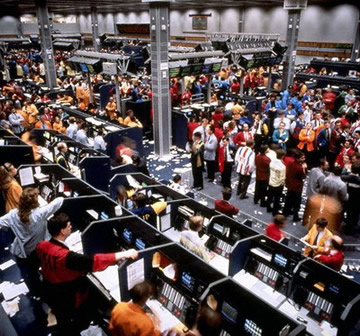Stock Exchanges
Stock Exchanges
Before discussing the financial markets, particularly stock exchanges, and how professional investors actually manage money, let's look at how stock exchanges work in general. While many people associate securities exchanges with raising money and speculation, exchanges exist because they facilitate commerce and trading.

How much do you know?
view quiz statisticsAn exchange is simply a place in which trades occur and fair prices are determined. An exchange facilitates the buying and selling of securities, the raising of capital, and the regulation of markets. Exchanges are typically owned by members who purchase seats that enable them to trade.
The exchanges are managed as businesses that earn revenues from listing fees which are paid by listed companies, by selling information such as stock prices, by charging for clearing trades, or by levying a tax on members.
While exchanges are typically governed by a Board of Directors and officers elected by members, many exchanges now include representatives of the investing public and listed companies.
Day-to-day operations are handled by a professional staff. Committees comprised of professional staff and exchange members provide regulatory oversight, review listing applications, select the specialist for a particular security, and monitor the trading practices of members.
The exchange also develops new products and promotes the services of members in order to increase trading volume. By increasing trading volume, members and the exchange have more opportunities to earn money. For example, an exchange charges the quotation vendors for each price quotation, or trade, reported on the tape. Increases in trading volume, therefore, have a direct impact on earnings.
A securities exchange facilitates fair price determination, provides liquidity, and fosters commerce.
Fair prices are determined by the matching of buy and sell orders, in other words, by the supply of and demand for a particular security. The fair price for a marketable security is simply that price at which a trade occurs between a willing buyer and a willing seller.
Liquidity refers to the depth of a market, which is the availability of a willing buyer or a willing seller when a broker’s customer wants to buy or sell a particular stock. Without liquidity, a market cannot exist for long. For example a lake (the market) would soon dry up if there were no tributaries (buyers and sellers) to feed the lake. The lake would soon become a dry bed and cease to exist. Liquidity is evaluated by the number and frequency of transactions, the speed of an order’s execution, the bid/ask spread, and the impact of a single trade upon the quoted price in the market.
Number of Transactions
On an average trading day, around 300 million trades are transacted. On heavy trading days the trading volume can exceed 600 million trades in a day.
Frequency of Transactions
During a normal business day, markets have short bursts of busy periods in which transactions are extremely frequent and long stretches of fairly quiet periods in which transactions are less frequent. During these busy periods, the markets tend to become either very bullish or very bearish, and sharp changes in prices can occur second by second. This brings more buyers and sellers into the market and increases that market’s liquidity.
Speed of Order Execution
The speed at which an order is executed is very important for the customers of the exchanges. The quicker they have confirmation of the price and amount of the transaction, and therefore their position, the quicker they can move on to their next transaction. In the U.S., an electronic routing system links member firms all over the U.S. directly to the floor of the New York Stock Exchange. This system provides information to the member firms’ customers with a minimum of delay.
The Bid-Ask Spread
Buyers and sellers of stocks will shy away from wide bid-ask spreads. This has the effect of taking the liquidity out of the market. If for example Bargain Electronics share price was $50 ½ (bid) - $54 (offer) a spread of $3 ½, the buyer would have to wait until the stock moved $3 ½ from $50 ½ to $54 to just break even. Don’t forget that you buy at the quoted offer rate and sell at the quoted bid rate.
If the spreads are narrow, then buyers and sellers are more active in the market, causing the market to become more liquid.
For example, a buyer purchasing Bargain Electronics ($54-$54 ½) at $54 ½ would only have to wait until the stock moved $.50 cents from $54 to $54 ½ to break even.
When the spreads between the bid and the offer side are small, a substantial size trade will quite often “move” the market in the direction of the trade. A buy will move the market up, and a sell will move the market down.
Knowledge among market participants that a market is fair also facilitates commerce. This is achieved by the regulation of securities markets, which includes disclosure of information and oversight of trading practices.
Now, let's briefly examine the mechanics of fair price determination. Perhaps an analogy will help put the role of an exchange in perspective. Soccer is a sport played by teams on a soccer field according to a set of rules. Likewise, market-making is a business practiced at an exchange according to a set of rules.
In all markets, trades occur when orders to buy and sell are “matched,” quantities are allocated, and a “fair price” is determined. For a market to exist, the system must also encompass a means of communicating with interested parties. Markets are distinguished by the priority given to orders, the automation of price discovery, and the disclosure of information.
There are several types or techniques for trading securities. Markets tend to utilize one technique rather than several.
Call Market
A call market is similar to an art auction at Sotheby’s or Christie’s, in which trading in a security may occur at a scheduled time or in rotation. This technique of trading is usually found in markets where trading volumes are low.
Negotiated Market
(Trader 1)
I can sell a thousand Intel at $113 ½.
(Trader 2)
Too high for me, how about $113 3/8ths?
(Trader 1)
Okay, I’ll do them at $113 3/8ths.
In a continuous trading market auction, prices are determined by a continuous two-sided auction. This technique of trading takes place in the New York Stock Exchange and the Tokyo Stock Exchange.
In my next layman’s guide, we will explore the world's largest organized exchanges.









